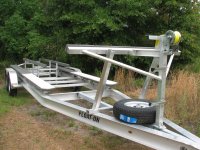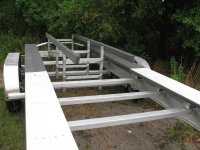matt_unique
New member
Bad Boy":3jf08fyu said:Matt,
You need the GLIDE ON model #86172. The product you are describing is for another application (I think they are called Slicks?)
George
Thanks George!
Bad Boy":3jf08fyu said:Matt,
You need the GLIDE ON model #86172. The product you are describing is for another application (I think they are called Slicks?)
George
I got my trailer from Float-on. I don't know if they'd be willing to provide the measurements to another vendor but I suspect not. I could perhaps measure it this weekend if I have time. The trailer is about 150 miles from me but I'll be out there fishing this weekend. Thataway Bob (Bob Austin) may have the measurements since he was the first one that got a Float-on for a TC 255. I just asked Float-on to duplicate what they did for Bob (copying Bob is often a good idea). Also Marc at Wefing may have some measurements as he had input on the Float-on design.cmetzenberg":154ocwxi said:Does anyone know where to get the templates for the trailer bunks? I'm getting a custom trailer made for my new tomcat and the guys at C-dory were only somewhat helpful. Going with Baja trailers in southern california.
cmetzenberg":271le4zj said:Does anyone know where to get the templates for the trailer bunks? I'm getting a custom trailer made for my new tomcat and the guys at C-dory were only somewhat helpful. Going with Baja trailers in southern california.


For reference, I paid a little over $9k for my Float-on. That was with electric over hydraulic disk brakes (Kodiak Cadmium coated) and a spare 8 lug 16" tire and hub mount. The weight difference between the aluminum and a corresponding galvanized trailer was substantial (if I recall about 800-1000lbs). The extra weight of the galvanized trailer would have put me over my tow capacity.redbaronace":tcbnsl46 said:cmetzenberg":tcbnsl46 said:Does anyone know where to get the templates for the trailer bunks? I'm getting a custom trailer made for my new tomcat and the guys at C-dory were only somewhat helpful. Going with Baja trailers in southern california.
Curious as to what a new 255 Trailer goes for.
I would have been in the market!!!lol. Good advice. I have bids with disk brakes and torsion axles for 8100. As for the 30' i'll dismiss that fantasy immediately, under 35 would be great though.gulfcoast john":3isxof3z said:Agree, you're dreaming. The 255 is over 30 ft with engines down on my rig.
Per my trailer guy, the physics precludes extending the tongue any even with a fixed tongue.
Triple axles can lower your rig hgt a bit, but my 11'6" (no radar but with RV AC) is well under the federal 13'6" standard. Downside more tire 'scuffing' in cornering turns (physics); when (not if) you have a blowout ALL TIRES ON THAT SIDE must be replaced as they were overloaded with probable structural damage.
Under certain conditions with torsion axles (highly rec'd over springs) one of two axles may be required to bear 100% of the load briefly...but if one of THREE axles is required to bear 100% of the load even briefly that's much worse (sharp uphill turn over railroad tracks etc).
Forget drum brakes, you can't clean them properly esp with saltwater exposure.
Get stainless rotors or at least Kodiak cadmium.
You are now north of $8000...
My 2010 came with a 2006 EZ loader...cost me over $4000 to bring it up to my trailer guys standards...should have got the FLOAT ON for $9500 and been done with it. But NOBODY is ever in the market for a used trailer for a 255.
When it's time to replace the entire light wiring harness (every 2 years or so in saltwater) highly recommend Grote Ultimate LED kit custom made for West Marine by the commercial truck lighting experts...$200 but 10 times better quality.
Best of luck and happy boating!
Cheers!
John
